PEP小学英语常见形容词及比较级、最高级变化一览表
常见形容词比较级最高级变化一览表
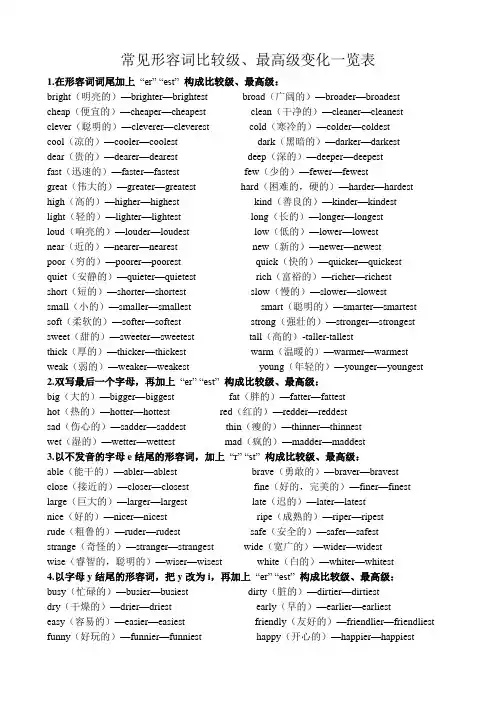
常见形容词比较级、最高级变化一览表1.在形容词词尾加上“er” “est” 构成比较级、最高级:bright(明亮的)—brighter—brightest broad(广阔的)—broader—broadestcheap(便宜的)—cheaper—cheapest clean(干净的)—cleaner—cleanest clever(聪明的)—cleverer—cleverest cold(寒冷的)—colder—coldestcool(凉的)—cooler—coolest dark(黑暗的)—darker—darkestdear(贵的)—dearer—dearest deep(深的)—deeper—deepestfast(迅速的)—faster—fastest few(少的)—fewer—fewestgreat(伟大的)—greater—greatest hard(困难的,硬的)—harder—hardest high(高的)—higher—highest kind(善良的)—kinder—kindestlight(轻的)—lighter—lightest long(长的)—longer—longestloud(响亮的)—louder—loudest low(低的)—lower—lowestnear(近的)—nearer—nearest new(新的)—newer—newestpoor(穷的)—poorer—poorest quick(快的)—quicker—quickestquiet(安静的)—quieter—quietest rich(富裕的)—richer—richestshort(短的)—shorter—shortest slow(慢的)—slower—slowestsmall(小的)—smaller—smallest smart(聪明的)—smarter—smartest soft(柔软的)—softer—softest strong(强壮的)—stronger—strongest sweet(甜的)—sweeter—sweetest tall(高的)-taller-tallestthick(厚的)—thicker—thickest warm(温暖的)—warmer—warmest weak(弱的)—weaker—weakest young(年轻的)—younger—youngest 2.双写最后一个字母,再加上“er” “est”构成比较级、最高级:big(大的)—bigger—biggest fat(胖的)—fatter—fattesthot(热的)—hotter—hottest red(红的)—redder—reddestsad(伤心的)—sadder—saddest thin(瘦的)—thinner—thinnestwet(湿的)—wetter—wettest mad(疯的)—madder—maddest3.以不发音的字母e结尾的形容词,加上“r” “st” 构成比较级、最高级:able(能干的)—abler—ablest brave(勇敢的)—braver—bravestclose(接近的)—closer—closest fine(好的,完美的)—finer—finest large(巨大的)—larger—largest late(迟的)—later—latestnice(好的)—nicer—nicest ripe(成熟的)—riper—ripestrude(粗鲁的)—ruder—rudest safe(安全的)—safer—safeststrange(奇怪的)—stranger—strangest wide(宽广的)—wider—widestwise(睿智的,聪明的)—wiser—wisest white(白的)—whiter—whitest4.以字母y结尾的形容词,把y改为i,再加上“er” “est”构成比较级、最高级:busy(忙碌的)—busier—busiest dirty(脏的)—dirtier—dirtiestdry(干燥的)—drier—driest early(早的)—earlier—earliesteasy(容易的)—easier—easiest friendly(友好的)—friendlier—friendliest funny(好玩的)—funnier—funniest happy(开心的)—happier—happiesthealthy(健康的)—healthier—healthiest heavy(重的)—heavier—heaviesthungry(饿的)—hungrier—hungriest lazy(懒惰的)—lazier—laziestlucky(幸运的)—luckier—luckiest naughty(调皮的)—naughtier—naughtiest noisy(嘈杂的)—noisier—noisiest pretty(美丽的)—prettier—prettiestsilly(傻的)—sillier—silliest spicy(辣的)—spicier—spiciestthirsty(渴的)—thirstier—thirstiest ugly(丑的)—uglier—ugliest5.双音节、多音节形容词,在单词前面加上“more” “most”构成比较级、最高级:afraid(害怕的)—more afraid—most afraidbeautiful(美丽的)—more beautiful—most beautifulcareful(仔细的)—more careful—most carefulcheerful(开心的)—more cheerful—most cheerfulcrowded(拥挤的)—more crowded—most crowdeddangerous(危险的)—more dangerous—most dangerousdelicious(美味的)—more delicious—most deliciousdifficult(困难的)—more difficult—most difficultexciting(令人兴奋的)—more exciting—most excitingexpensive(昂贵的)—more expensive—most expensivefamous(著名的)—more famous—most famousfrightened(受惊的)—more frightened—most frightenedfrightening(令人害怕的)—more frightening—most frighteninghard-working(勤奋的)—more hard-working—most hard-workinghelpful(有帮助的)—more helpful—most helpfulhonest(诚实的)—more honest—most honestimportant(重要的)—more important—most importantinteresting(有趣的)—more interesting—most interestingpolite(有礼貌的)—more polite—most politeterrible(可怕的)—more terrible—most terribletired(累的)—more tired—most tired6.不规则变化的形容词:bad(坏的)—worse—worst far(远的)—farther—farthest (far—further—furthest)good(好的)—better—best ill(病的)—worse—worstlittle(少的)—less—least many(多的)—more—most much(多的)—more—most old(年老的)—older—oldest ( old—elder—eldest) well(好的,身体好的)—better—best。
常见形容词比较级最高级变化一览表
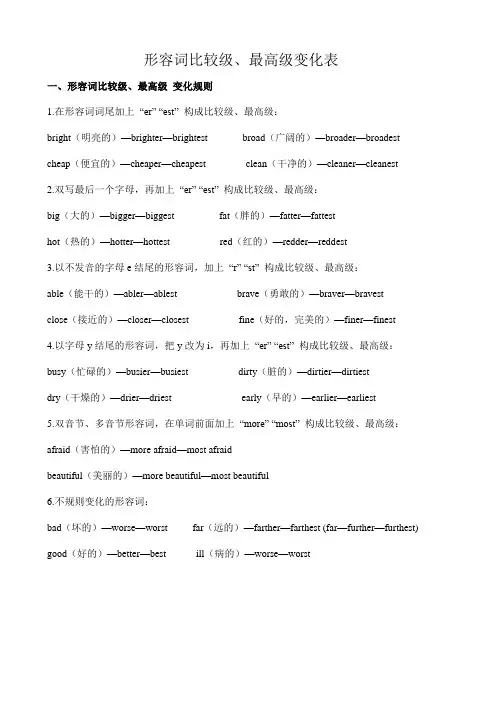
形容词比较级、最高级变化表一、形容词比较级、最高级变化规则1.在形容词词尾加上“er” “est” 构成比较级、最高级:bright(明亮的)—brighter—brightest broad(广阔的)—broader—broadest cheap(便宜的)—cheaper—cheapest clean(干净的)—cleaner—cleanest2.双写最后一个字母,再加上“er” “est” 构成比较级、最高级:big(大的)—bigger—biggest fat(胖的)—fatter—fattesthot(热的)—hotter—hottest red(红的)—redder—reddest3.以不发音的字母e结尾的形容词,加上“r” “st” 构成比较级、最高级:able(能干的)—abler—ablest brave(勇敢的)—braver—bravestclose(接近的)—closer—closest fine(好的,完美的)—finer—finest4.以字母y结尾的形容词,把y改为i,再加上“er” “est” 构成比较级、最高级:busy(忙碌的)—busier—busiest dirty(脏的)—dirtier—dirtiestdry(干燥的)—drier—driest early(早的)—earlier—earliest5.双音节、多音节形容词,在单词前面加上“more” “most” 构成比较级、最高级:afraid(害怕的)—more afraid—most afraidbeautiful(美丽的)—more beautiful—most beautiful6.不规则变化的形容词:bad(坏的)—worse—worst far(远的)—farther—farthest (far—further—furthest) good(好的)—better—best ill(病的)—worse—worst二、形容词比较级和最高级句型(特殊)比较级句型:1.在形容词比较级前还可以用much, even, still, a little,……来修饰,表示“……的多”,“甚至……”,“更……”,“……一些”。
英语常见形容词及比较级、最高级变化一览表
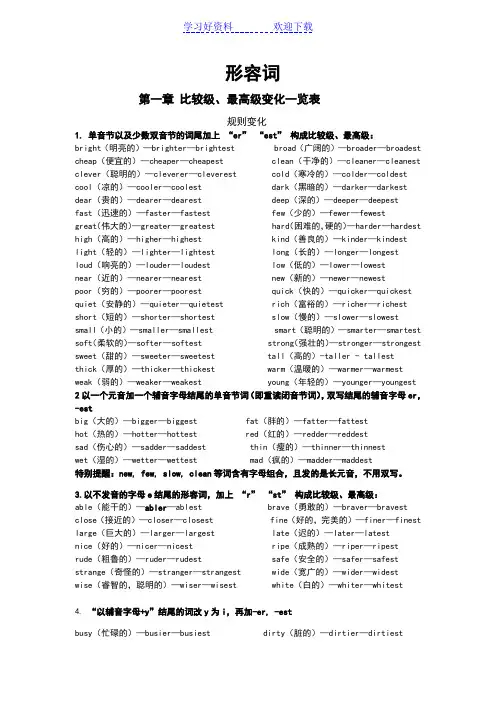
形容词第一章比较级、最高级变化一览表规则变化1.单音节以及少数双音节的词尾加上“er”“est”构成比较级、最高级:bright(明亮的)—brighter—brightest broad(广阔的)—broader—broadestcheap(便宜的)—cheaper—cheapest clean(干净的)—cleaner—cleanest clever(聪明的)—cleverer—cleverest cold(寒冷的)—colder—coldestcool(凉的)—cooler—coolest dark(黑暗的)—darker—darkestdear(贵的)—dearer—dearest deep(深的)—deeper—deepestfast(迅速的)—faster—fastest few(少的)—fewer—fewestgreat(伟大的)—greater—greatest hard(困难的,硬的)—harder—hardesthigh(高的)—higher—highest kind(善良的)—kinder—kindestlight(轻的)—lighter—lightest long(长的)—longer—longestloud(响亮的)—louder—loudest low(低的)—lower—lowestnear(近的)—nearer—nearest new(新的)—newer—newestpoor(穷的)—poorer—poorest quick(快的)—quicker—quickestquiet(安静的)—quieter—quietest rich(富裕的)—richer—richestshort(短的)—shorter—shortest slow(慢的)—slower—slowestsmall(小的)—smaller—smallest smart(聪明的)—smarter—smartestsoft(柔软的)—softer—softest strong(强壮的)—stronger—strongestsweet(甜的)—sweeter—sweetest tall(高的)-taller - tallest thick(厚的)—thicker—thickest warm(温暖的)—warmer—warmestweak(弱的)—weaker—weakest young(年轻的)—younger—youngest2以一个元音加一个辅音字母结尾的单音节词(即重读闭音节词),双写结尾的辅音字母er,-estbig(大的)—bigger—biggest fat(胖的)—fatter—fattesthot(热的)—hotter—hottest red(红的)—redder—reddestsad(伤心的)—sadder—saddest thin(瘦的)—thinner—thinnestwet(湿的)—wetter—wettest mad(疯的)—madder—maddest特别提醒:new, few, slow, clean等词含有字母组合,且发的是长元音,不用双写。
英语常见形容词及比较级、最高级变化一览表(空白)
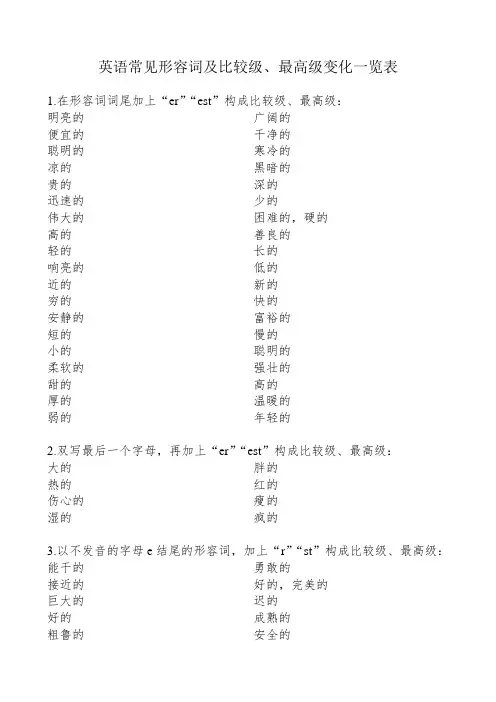
英语常见形容词及比较级、最高级变化一览表
1.在形容词词尾加上“er”“est”构成比较级、最高级:
明亮的广阔的
便宜的干净的
聪明的寒冷的
凉的黑暗的
贵的深的
迅速的少的
伟大的困难的,硬的
高的善良的
轻的长的
响亮的低的
近的新的
穷的快的
安静的富裕的
短的慢的
小的聪明的
柔软的强壮的
甜的高的
厚的温暖的
弱的年轻的
2.双写最后一个字母,再加上“er”“est”构成比较级、最高级:
大的胖的
热的红的
伤心的瘦的
湿的疯的
3.以不发音的字母e结尾的形容词,加上“r”“st”构成比较级、最高级:能干的勇敢的
接近的好的,完美的
巨大的迟的
好的成熟的
粗鲁的安全的
奇怪的宽广的
睿智的,聪明的白的
4.以字母y结尾的形容词,把y改为i,再加上“er”“est”构成比较级、最高级:
忙碌的脏的
干燥的早的
容易的友好的
好玩的开心的
健康的有钱的
饿的懒惰的
幸运的调皮的
嘈杂的美丽的
傻的辣的
渴的丑的
重的
5.双音节、多音节形容词,在单词前面加上“more”“most”构成比较级、最高级:
害怕的
美丽的
仔细的
开心的
拥挤的
危险的
美味的
困难的
令人兴奋的
昂贵的
著名的
受惊的
令人害怕的
勤奋的
有帮助的
诚实的
重要的
有趣的
有礼貌的
可怕的
累的
6.不规则变化的形容词
坏的远的好的病的少的多的多的年老的好的,身体好的。
常见形容词比较级最高级变化一览表
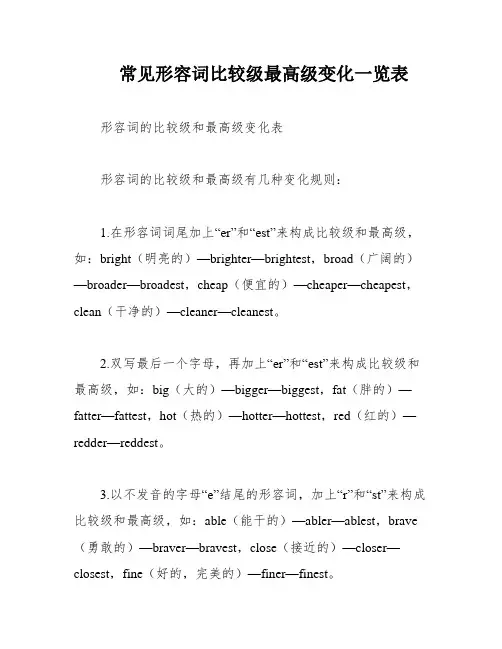
常见形容词比较级最高级变化一览表形容词的比较级和最高级变化表形容词的比较级和最高级有几种变化规则:1.在形容词词尾加上“er”和“est”来构成比较级和最高级,如:bright(明亮的)—brighter—brightest,broad(广阔的)—broader—broadest,cheap(便宜的)—cheaper—cheapest,clean(干净的)—cleaner—cleanest。
2.双写最后一个字母,再加上“er”和“est”来构成比较级和最高级,如:big(大的)—bigger—biggest,fat(胖的)—fatter—fattest,hot(热的)—hotter—hottest,red(红的)—redder—reddest。
3.以不发音的字母“e”结尾的形容词,加上“r”和“st”来构成比较级和最高级,如:able(能干的)—abler—ablest,brave (勇敢的)—braver—bravest,close(接近的)—closer—closest,fine(好的,完美的)—finer—finest。
4.以字母“y”结尾的形容词,把“y”改为“i”,再加上“er”和“est”来构成比较级和最高级,如:busy(忙碌的)—busier—busiest,dirty(脏的)—dirtier—dirtiest,dry(干燥的)—drier—driest,early(早的)—earlier—earliest。
5.双音节、多音节形容词,在单词前面加上“more”和“most”来构成比较级和最高级,如:afraid(害怕的)—more afraid—most afraid,beautiful(美丽的)—more beautiful—most beautiful。
6.不规则变化的形容词有:bad(坏的)—worse—worst,far(远的)—farther—farthest(far—further—furthest),good (好的)—better—best,ill(病的)—worse—worst。
(完整版)常见形容词比较级最高级变化一览表.doc
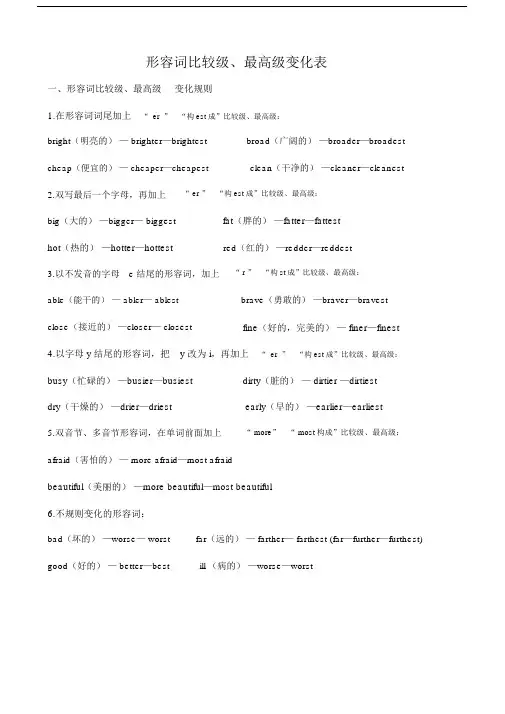
形容词比较级、最高级变化表一、形容词比较级、最高级变化规则1.在形容词词尾加上“ er” “构est成”比较级、最高级:bright(明亮的)— brighter—brightest broad(广阔的)—broader—broadest cheap(便宜的)— cheaper—cheapest clean(干净的)—cleaner—cleanest 2.双写最后一个字母,再加上“ er ” “构est成”比较级、最高级:big(大的)—bigger— biggest fat(胖的)—fatter—fattesthot(热的)—hotter—hottest red(红的)—redder—reddest3.以不发音的字母 e 结尾的形容词,加上“ r ” “构st成”比较级、最高级:able(能干的)— abler— ablest brave(勇敢的)—braver—bravest close(接近的)—closer— closest fine(好的,完美的)— finer—finest 4.以字母 y 结尾的形容词,把y 改为 i,再加上“ er” “构est成”比较级、最高级:busy(忙碌的)—busier—busiestdry(干燥的)—drier—driest5.双音节、多音节形容词,在单词前面加上dirty(脏的)— dirtier —dirtiest early(早的)—earlier—earliest“ more” “ most构成”比较级、最高级:afraid(害怕的)— more afraid—most afraidbeautiful(美丽的)—more beautiful—most beautiful6.不规则变化的形容词:bad(坏的)—worse— worst far(远的)— farther— farthest (far—further—furthest) good(好的)— better—best ill (病的)—worse—worst二、形容词比较级和最高级句型(特殊)比句型:1.在形容比前可以用 much, even, still, a little,⋯⋯来修,表示“⋯⋯的多”,“甚至⋯⋯”,“更⋯⋯”,“⋯⋯一些”。
小学英语常见形容词及比较级、最高级变化一览表
小学英语常见形容词及比较级、最高级变化一览表第一篇:小学英语常见形容词及比较级、最高级变化一览表小学英语常见形容词及比较级、最高级变化一览表1.在形容词词尾加上“er” “est” 构成比较级、最高级:bright(明亮的)—brighter—brightestbroad(广阔的)—broader—broadestcheap(便宜的)—cheaper—cheapestclean(干净的)—cleaner—cleanestclever(聪明的)—cleverer—cleverestcold(寒冷的)—colder—coldestcool(凉的)—cooler—coolestdear(贵的)—dearer—dearestfast(迅速的)—faster—fastestgreat(伟大的)—greater—greatesthigh(高的)—higher—highestlight(轻的)—lighter—lightestloud(响亮的)—louder—loudestnear(近的)—nearer—nearestpoor(穷的)—poorer—poorestquiet(安静的)—quieter—quietestshort(短的)—shorter—shortestsmall(小的)—smaller—smallestsoft(柔软的)—softer—softestsweet(甜的)—sweeter—sweetestthick(厚的)—thicker—thickestweak(弱的)—weaker—weakestdark(黑暗的)—darker—darkestdeep(深的)—deeper—deepestfew(少的)—fewer—fewesthard(困难的,硬的)—harder—hardestkind(善良的)—kinder—kindestlong(长的)—longer—longestlow(低的)—lower—lowestnew(新的)—newer—newestquick(快的)—quicker—quickestrich(富裕的)—richer—richestslow(慢的)—slower—slowestsmart(聪明的)—smarter—smarteststrong(强壮的)—stronger—strongesttall(高的)-taller-tallestwarm(温暖的)—warmer—warmestyoung(年轻的)—younger—youngest2.双写最后一个字母,再加上“er” “est” 构成比较级、最高级:big(大的)—bigger—biggestfat(胖的)—fatter—fattesthot(热的)—hotter—hottestred(红的)—redder—reddestsad(伤心的)—sadder—saddestthin(瘦的)—thinner—thinnestwet(湿的)—wetter—wettestmad(疯的)—madder—maddest3.以不发音的字母e结尾的形容词,加上“r” “st” 构成比较级、最高级:able(能干的)—abler—ablestbrave(勇敢的)—braver—bravestclose(接近的)—closer—closestfine(好的,完美的)—finer—finestlarge(巨大的)—larger—largestlate(迟的)—later—latestnice(好的)—nicer—nicestripe(成熟的)—riper—ripestrude(粗鲁的)—ruder—rudestsafe(安全的)—safer—safeststrange(奇怪的)—stranger—strangestwide(宽广的)—wider—widestwise(睿智的,聪明的)—wiser—wisestwhite(白的)—whiter—whitest4.以字母y结尾的形容词,把y改为i,再加上“er” “est” 构成比较级、最高级:busy(忙碌的)—busier—busiestdirty(脏的)—dirtier—dirtiestdry(干燥的)—drier—driestearly(早的)—earlier—earliesteasy(容易的)—easier—easiestfriendly(友好的)—friendlier—friendliestfunny(好玩的)—funnier—funniesthappy(开心的)—happier—happiesthealthy(健康的)—healthier—healthiestheavy(重的)—heavier—heaviesthungry(饿的)—hungrier—hungriestlazy(懒惰的)—lazier—laziestlucky(幸运的)—luckier—luckiestnaughty(调皮的)—naughtier—naughtiestnoisy(嘈杂的)—noisier—noisiestpretty(美丽的)—prettier—prettiestsilly(傻的)—sillier—silliestspicy(辣的)—spicier—spiciestthirsty(渴的)—thirstier—thirstiestugly(丑的)—uglier—ugliest5.双音节、多音节形容词,在单词前面加上“more” “most” 构成比较级、最高级:afraid(害怕的)—more afraid—most afraidbeautiful(美丽的)—more beautiful—most beautiful careful (仔细的)—more careful—most carefulcheerful(开心的)—more cheerful—most cheerfulcrowded(拥挤的)—more crowded—most crowdeddangerous(危险的)—more dangerous—most dangerous delicious(美味的)—more delicious—most deliciousdifficult(困难的)—more difficult—most difficultexciting(令人兴奋的)—more exciting—most excitingexpensive(昂贵的)—more expensive—most expensive famous(著名的)—more famous—most famousfrightened(受惊的)—more frightened—most frightened frightening(令人害怕的)—more frightening—most frightening hard-working(勤奋的)—more hard-working—most hard-workinghelpful(有帮助的)—more helpful—most helpfulhonest(诚实的)—more honest—most honestimportant(重要的)—more important—most important interesting(有趣的)—more interesting—most interesting polite(有礼貌的)—more polite—most politeterrible(可怕的)—more terrible—most terribletired(累的)—more tired—most tired6.不规则变化的形容词:bad(坏的)—worse—worstfar(远的)—farther—farthest(far—further—furthest)good(好的)—better—bestill(病的)—worse—worstlittle(少的)—less—leastmany(多的)—more—mostmuch(多的)—more—mostold(年老的)—older—oldest(old—elder—eldest)well(好的,身体好的)—better—best1.一般在词尾直接加er或est, 例如,tall-taller-tallest,long-longer-longest2.以不发音的字母e结尾的单词在词尾直接加r或st, 例如,nice-nicer-nicest3.以辅音字母+y结尾的词,把y变为i,再加er 或est, 例如,heavy-heavier-heaviest4.重读闭音节,末尾只有一个辅音字母,双写这个辅音字母,再加er或est, 例如,big-bigger-biggest5.部分双音节词和多音节词分别在原级前加more构成比较级和most构成最高级, 例如,slowly-more slowly-most slowly;beautiful-more beautiful-most beautiful一、形容词、副词的比较级和最高级的构成规则1.一般单音节词和少数以-er,-ow结尾的双音节词,比较级在后面加-er,最高级在后面加-est;(1)单音节词如:small→smaller→smallest short→shorter→shortest tall→taller→tallest great→greater→great est(2)双音节词如:clever→cleverer→cleverest narrow→narrower→narrowest 2.以不发音e结尾的单音节词,比较在原级后加-r,最高级在原级后加-st;如:large→larger→largest nice→nicer→nicest able→abler→ablest 3.在重读闭音节(即:辅音+元音+辅音)中,先双写末尾的辅音字母,比较级加-er,最高级加-est;如:big→bigger→biggest hot→hotter→hottest fat→fatter→fattest 4.以“辅音字母+y”结尾的双音节词, 把y改为i,比较级加-er,最高级加-est;如:easy→easier→easiest heavy→heavier→heaviest busy→busier→busiest happy→happier→happiest 5.其他双音节词和多音节词,比较级在前面加more,最高级在前面加most;如:beautiful→morebeautiful→most beautiful different→more different→mo st different easily→more easily→most easily 注意:(1)形容词最高级前通常必须用定冠词 the,副词最高级前可不用.例句: The Sahara is the biggest desert in the world.(2)形容词most前面没有the,不表示最高级的含义,只表示“非常”.It is a most important problem.=It is a very important problem.6.有少数形容词、副词的比较级和最高级是不规则的,必须熟记.如:good→better→best well→better→best bad→worse→worst ill→worse→worst old→older/elder→oldest/eldest many/much→more→most little→less→least far →further/farther→ furthest/farthest二、形容词、副词的比较级和最高级的用法1.“A + be +形容词比较级+ than + B” 意思为“A比B更……”.如:This tree is taller than that one.这棵树比那棵树高.注意:① 在含有连词than的比较级中,前后的比较对象必须是同一范畴,即同类事物之间的比较.②在比较级前面使用much,表示程度程度“强得多”.如:A watermelon is much bigger than an apple.③ very, quite一般只能修饰原级,不能修饰比较级.2.“比较级 + and + 比较级”或“more and more +原级”表示“越来越……” 如:It becomes warmer and warmer when spring comes.春天来了,天气变得越来越暖和了.It is getting cooler and cooler.天气越来越凉爽.The wind became more and more heavily.风变得越来越大.Our school is becoming more and more beautiful.我们的学校变得越来越美丽.3.在含有or的选择疑问句中,如果有两者供选择,前面的形容词要用比较级形式.如:Who is taller,Tim or T om? 谁更高,Tim还是Tom?4.“the +比较级……, the+比较级”,表示“越……越……”.The more money you make, the more you spend.钱你赚得越多,花得越多.The sooner,the better.越快越好.5.表示倍数的比较级用法:①.A is …times the size /height/length/width of B.如:The new building is three times the height of the old one.这座新楼比那座旧楼高三倍.(新楼是旧楼的四倍高)②.A is …times as big/high/long/wide/large as B.如:Asia is four times as large as Europe.亚洲是欧洲的四倍大.(亚洲比欧洲大三倍)③.A is …times larger /higher/longer/wider than B.如:Our school is twice bigger than yours.我们学校比你们学校大两倍.6.形容词、副词的最高级形式主要用来表示三者或三者以上人或事物的比较,表示“最……”的意思.句子中有表示范围的词或短语.如:of the three, in our class等等.如:He is the tallest in our class.他在我们班里是最高的.7.“否定词语+比较级”,“否定词语+ so… as”结构表示最高级含义.Nothing is so easy as this.=Nothing is easier than this.=This is the easiest thing.8.比较级与最高级的转换: Mike is the most intelligent in his class.Mike is more intelligent than any other student in his class 7.修饰比较级和最高级的词 1)可修饰比较级的词①.a bit, a little, rather, much, far, by far, many, a lot, lots, a great deal, any, still, even等.②.还可以用表示倍数的词或度量名词作修饰语.③.以上词(除by far)外,必须置于比较级形容词或副词的前面.注意:使用最高级要注意将主语包括在比较范围内.(错)Tom is the tallest of his three brothers.(对)Tom is the tallest of the three brothers.2)下列词可修饰最高级:by far, far, much, mostly, almost.This hat is nearly / almost the biggest.注意:a.very可修饰最高级,但位置与much不同.This is the very best.This is much the best.b.序数词通常只修饰最高级.Africa is the second largest continent.8.要避免重复使用比较级.(错)He is more cleverer than his brother.(对)He is more clever than his brother.(对)He is cleverer than his brother.9.要避免将主语含在比较对象中.(错)China is larger that any country in Asia.(对)China is larger than any other country in Asia.10.要注意对应句型,遵循前后一致的原则.The population of Shanghai is larger than that of Beijing.It is easier to make a plan than to carry it out.11.要注意冠词的使用,后有名词的时候,前面才有可能有名词.比较:Which is larger, Canada or Australia? Which is the larger country, Canada orAustralia? She is taller than her two sisters.She is the taller of the two sisters.第二篇:小学常见形容词比较级和最高级小学常见形容词比较级和最高级I.记忆口诀形容词的比较级,一好一坏要记牢;good更好是better,坏的更坏是worse;结尾有e只加r, nice变成nicer;若是遇到 y 结尾,把 y 变 i 加er;其余全部加er.(注:虽然口诀并不能涵盖所有形容词比较级变化的方式,但也是一个不错的记忆小窍门。
英语常见形容词及比较级、最高级变化一览表
形容词第一章比较级、最高等变化一览表规则变化1. 单音节以及少量双音节的词尾加上“ er ” “ est ”组成比较级、最高等:bright (光亮的)— brighter — brightest broad(广阔的)— broader — broadest cheap(廉价的)— cheaper —cheapest clean(洁净的)— cleaner — cleanest clever (聪慧的)— cleverer — cleverest cold(严寒的)— colder— coldestcool (凉的)— cooler — coolest dark(黑暗的)— darker— darkest dear (贵的)— dearer — dearest deep(深的)— deeper —deepestfast (快速的)— faster — fastest few(少的)— fewer — fewestgreat(伟大的)— greater — greatest hard(困难的,硬的)— harder — hardest high (高的)— higher — highest kind(和善的)— kinder— kindestlight (轻的)— lighter— lightest long(长的)— longer —longestloud (响亮的)— louder— loudest low(低的)— lower — lowestnear (近的)— nearer — nearest new(新的)— newer— newestpoor (穷的)— poorer — poorest quick(快的)— quicker— quickest quiet (寂静的)— quieter —quietest rich(富饶的)— richer— richest short (短的)— shorter — shortest slow(慢的)— slower —slowestsmall (小的)— smaller — smallest smart(聪慧的)— smarter — smartest soft(柔嫩的)—softer —softest strong(强健的)— stronger— strongest sweet (甜的)— sweeter— sweetest tall(高的) -taller - tallestthick (厚的)— thicker— thickest warm(暖和的)— warmer— warmest weak(弱的)— weaker — weakest young(年青的)— younger — youngest2 以一个元音加一个辅音字母结尾的单音节词(即重读闭音节词),双写结尾的辅音字母 er ,-estbig (大的)— bigger— biggest fat(胖的)— fatter — fattesthot (热的)— hotter— hottest red(红的)— redder — reddestsad(悲伤的)— sadder — saddest thin(瘦的)— thinner — thinnestwet (湿的)— wetter — wettest mad(疯的)— madder— maddest特别提示: new, few, slow, clean等词含有字母组合,且发的是长元音,不用双写。
英语常见形容词及比较级、最高级变化一览表格模板
英语常见形容词及比较级、最高级变化一览表1.在形容词词尾加上“er” “est” 构成比较级、最高级:bright(明亮的)—brighter—brightest broad(广阔的)—broader—broadestcheap(便宜的)—cheaper—cheapest clean(干净的)—cleaner—cleanest clever(聪明的)—cleverer—cleverest cold(寒冷的)—colder—coldest cool(凉的)—cooler—coolest dark(黑暗的)—darker—darkest dear(贵的)—dearer—dearest deep(深的)—deeper—deepest fast(迅速的)—faster—fastest few(少的)—fewer—fewest great(伟大的)—greater—greatest hard(困难的,硬的)—harder—hardesthigh(高的)—higher—highest kind(善良的)—kinder—kindest light(轻的)—lighter—lightest long(长的)—longer—longest loud(响亮的)—louder—loudest low(低的)—lower—lowest near(近的)—nearer—nearest new(新的)—newer—newest poor(穷的)—poorer—poorest quick(快的)—quicker—quickest quiet(安静的)—quieter—quietest rich(富裕的)—richer—richest short(短的)—shorter—shortest slow(慢的)—slower—slowest small(小的)—smaller—smallest smart(聪明的)—smarter—smartestsoft(柔软的)—softer—softest strong(强壮的)—stronger—strongestsweet(甜的)—sweeter—sweetest tall(高的)-taller-tallest thick(厚的)—thicker—thickest warm(温暖的)—warmer—warmest weak(弱的)—weaker—weakest young(年轻的)—younger—youngest2.双写最后一个字母,再加上“er” “est” 构成比较级、最高级:big(大的)—bigger—biggest fat(胖的)—fatter—fattesthot(热的)—hotter—hottest red(红的)—redder—reddest sad(伤心的)—sadder—saddest thin(瘦的)—thinner—thinnest wet(湿的)—wetter—wettest mad(疯的)—madder—maddest3.以不发音的字母e结尾的形容词,加上“r” “st” 构成比较级、最高级:able(能干的)—abler—ablest brave(勇敢的)—braver—bravest close(接近的)—closer—closest fine(好的,完美的)—finer—finest large(巨大的)—larger—largest late(迟的)—later—latest nice(好的)—nicer—nicest ripe(成熟的)—riper—ripest rude(粗鲁的)—ruder—rudest safe(安全的)—safer—safest strange(奇怪的)—stranger—strangest wide(宽广的)—wider—widest wise(睿智的,聪明的)—wiser—wisest white(白的)—whiter—whitest4.以字母y结尾的形容词,把y改为i,再加上“er” “est” 构成比较级、最高级:busy(忙碌的)—busier—busiest dirty(脏的)—dirtier—dirtiest dry(干燥的)—drier—driest early(早的)—earlier—earliest easy(容易的)—easier—easiest friendly(友好的)—friendlier—friendliestfunny(好玩的)—funnier—funniest happy(开心的)—happier—happiesthealthy(健康的)—healthier—healthiest heavy(重的)—heavier—heaviest hungry(饿的)—hungrier—hungriest lazy(懒惰的)—lazier—laziest lucky(幸运的)—luckier—luckiest naughty(调皮的)—naughtier—naughtiestnoisy(嘈杂的)—noisier—noisiest pretty(美丽的)—prettier—prettiest silly(傻的)—sillier—silliest spicy(辣的)—spicier—spiciest thirsty(渴的)—thirstier—thirstiest ugly(丑的)—uglier—ugliest 5.双音节、多音节形容词,在单词前面加上“more” “most” 构成比较级、最高级:afraid(害怕的)—more afraid—most afraidbeautiful(美丽的)—more beautiful—most beautifulcareful(仔细的)—more careful—most carefulcheerful(开心的)—more cheerful—most cheerfulcrowded(拥挤的)—more crowded—most crowdeddangerous(危险的)—more dangerous—most dangerousdelicious(美味的)—more delicious—most deliciousdifficult(困难的)—more difficult—most difficultexciting(令人兴奋的)—more exciting—most excitingexpensive(昂贵的)—more expensive—most expensivefamous(著名的)—more famous—most famousfrightened(受惊的)—more frightened—most frightenedfrightening(令人害怕的)—more frightening—most frighteninghard-working(勤奋的)—more hard-working—most hard-workinghelpful(有帮助的)—more helpful—most helpfulhonest(诚实的)—more honest—most honestimportant(重要的)—more important—most importantinteresting(有趣的)—more interesting—most interestingpolite(有礼貌的)—more polite—most politeterrible(可怕的)—more terrible—most terribletired(累的)—more tired—most tired6.不规则变化的形容词:bad(坏的)—worse—worstfar(远的)—farther—farthest (far—further—furthest)good(好的)—better—bestill(病的)—worse—worstlittle(少的)—less—leastmany(多的)—more—mostmuch(多的)—more—mostold(年老的)—older—oldest ( old—elder—eldest)well(好的,身体好的)—better—best形容词的比较级和最高级: 形容词的比较级和最高级形式是在形容词的原级形式的基础上变化的。
英语常见形容词及比较级、最高级变化一览表
英语常见形容词及比较级、最高级变化一览表1.在形容词词尾加上“er” “est” 构成比较级、最高级:bright(明亮的)—brighter—brightest broad(广阔的)—broader—broadest cheap(便宜的)—cheaper—cheapest clean(干净的)—cleaner—cleanest clever(聪明的)—cleverer—cleverest cold(寒冷的)—colder—coldestcool(凉的)—cooler—coolest dark(黑暗的)—darker—darkestdear(贵的)—dearer—dearest deep(深的)—deeper—deepestfast(迅速的)—faster—fastest few(少的)—fewer—fewestgreat(伟大的)—greater—greatest hard(困难的,硬的)—harder—hardest high(高的)—higher—highest kind(善良的)—kinder—kindestlight(轻的)—lighter—lightest long(长的)—longer—longestloud(响亮的)—louder—loudest low(低的)—lower—lowestnear(近的)—nearer—nearest new(新的)—newer—newestpoor(穷的)—poorer—poorest quick(快的)—quicker—quickest quiet(安静的)—quieter—quietest rich(富裕的)—richer—richestshort(短的)—shorter—shortest slow(慢的)—slower—slowestsmall(小的)—smaller—smallest smart(聪明的)—smarter—smartest soft(柔软的)—softer—softest strong(强壮的)—stronger—strongest sweet(甜的)—sweeter—sweetest tall(高的)-taller-tallestthick(厚的)—thicker—thickest warm(温暖的)—warmer—warmest weak(弱的)—weaker—weakest young(年轻的)—younger—youngest2.双写最后一个字母,再加上“er” “est” 构成比较级、最高级:big(大的)—bigger—biggest fat(胖的)—fatter—fattesthot(热的)—hotter—hottest red(红的)—redder—reddestsad(伤心的)—sadder—saddest thin(瘦的)—thinner—thinnestwet(湿的)—wetter—wettest mad(疯的)—madder—maddest3.以不发音的字母e结尾的形容词,加上“r” “st” 构成比较级、最高级:able(能干的)—abler—ablest brave(勇敢的)—braver—bravest close(接近的)—closer—closest fine(好的,完美的)—finer—finest large(巨大的)—larger—largest late(迟的)—later—latestnice(好的)—nicer—nicest ripe(成熟的)—riper—ripestrude(粗鲁的)—ruder—rudest safe(安全的)—safer—safeststrange(奇怪的)—stranger—strangest wide(宽广的)—wider—widestwise(睿智的,聪明的)—wiser—wisest white(白的)—whiter—whitest4.以字母y结尾的形容词,把y改为i,再加上“er” “est” 构成比较级、最高级:busy(忙碌的)—busier—busiest dirty(脏的)—dirtier—dirtiestdry(干燥的)—drier—driest early(早的)—earlier—earliesteasy(容易的)—easier—easiest friendly(友好的)—friendlier—friendliest funny(好玩的)—funnier—funniest happy(开心的)—happier—happiest healthy(健康的)—healthier—healthiest heavy(重的)—heavier—heaviesthungry(饿的)—hungrier—hungriest lazy(懒惰的)—lazier—laziestlucky(幸运的)—luckier—luckiest naughty(调皮的)—naughtier—naughtiest noisy(嘈杂的)—noisier—noisiest pretty(美丽的)—prettier—prettiest silly(傻的)—sillier—silliest spicy(辣的)—spicier—spiciestthirsty(渴的)—thirstier—thirstiest ugly(丑的)—uglier—ugliest5.双音节、多音节形容词,在单词前面加上“more” “most” 构成比较级、最高级:afraid(害怕的)—more afraid—most afraidbeautiful(美丽的)—more beautiful—most beautifulcareful(仔细的)—more careful—most carefulcheerful(开心的)—more cheerful—most cheerfulcrowded(拥挤的)—more crowded—most crowdeddangerous(危险的)—more dangerous—most dangerousdelicious(美味的)—more delicious—most deliciousdifficult(困难的)—more difficult—most difficultexciting(令人兴奋的)—more exciting—most excitingexpensive(昂贵的)—more expensive—most expensivefamous(著名的)—more famous—most famousfrightened(受惊的)—more frightened—most frightenedfrightening(令人害怕的)—more frightening—most frighteninghard-working(勤奋的)—more hard-working—most hard-workinghelpful(有帮助的)—more helpful—most helpfulhonest(诚实的)—more honest—most honestimportant(重要的)—more important—most importantinteresting(有趣的)—more interesting—most interestingpolite(有礼貌的)—more polite—most politeterrible(可怕的)—more terrible—most terribletired(累的)—more tired—most tired6.不规则变化的形容词:bad(坏的)—worse—worstfar(远的)—farther—farthest (far—further—furthest)good(好的)—better—bestill(病的)—worse—worstlittle(少的)—less—leastmany(多的)—more—mostmuch(多的)—more—mostold(年老的)—older—oldest ( old—elder—eldest)well(好的,身体好的)—better—best。
- 1、下载文档前请自行甄别文档内容的完整性,平台不提供额外的编辑、内容补充、找答案等附加服务。
- 2、"仅部分预览"的文档,不可在线预览部分如存在完整性等问题,可反馈申请退款(可完整预览的文档不适用该条件!)。
- 3、如文档侵犯您的权益,请联系客服反馈,我们会尽快为您处理(人工客服工作时间:9:00-18:30)。
PEP小学英语常见形容词及比较级、最高级变化一览表
1.在形容词词尾加上“er” “est” 构成比较级、最高级:
bright(明亮的)—brighter—brightest broad(广阔的)—broader—broadest cheap(便宜的)—cheaper—cheapest clean(干净的)—cleaner—cleanest clever(聪明的)—cleverer—cleverest cold(寒冷的)—colder—coldest cool(凉的)—cooler—coolest dark(黑暗的)—darker—darkest dear(贵的)—dearer—dearest deep(深的)—deeper—deepest fast(迅速的)—faster—fastest few(少的)—fewer—fewest
great(伟大的)—greater—greatest hard(困难的,硬的)—harder—hardest high(高的)—higher—highest kind(善良的)—kinder—kindest light(轻的)—lighter—lightest long(长的)—longer—longest loud(响亮的)—louder—loudest low(低的)—lower—lowest near(近的)—nearer—nearest new(新的)—newer—newest poor(穷的)—poorer—poorest quick(快的)—quicker—quickest quiet(安静的)—quieter—quietest rich(富裕的)—richer—richest short(短的)—shorter—shortest slow(慢的)—slower—slowest small(小的)—smaller—smallest smart(聪明的)—smarter—smartest soft(柔软的)—softer—softest strong(强壮的)—stronger—strongest sweet(甜的)—sweeter—sweetest tall(高的)-taller-tallest
thick(厚的)—thicker—thickest warm(温暖的)—warmer—warmest weak(弱的)—weaker—weakest young(年轻的)—younger—youngest
2.双写最后一个字母,再加上“er” “est”构成比较级、最高级:
big(大的)—bigger—biggest fat(胖的)—fatter—fattest
hot(热的)—hotter—hottest red(红的)—redder—reddest
sad(伤心的)—sadder—saddest thin(瘦的)—thinner—thinnest
wet(湿的)—wetter—wettest mad(疯的)—madder—maddest
3.以不发音的字母e结尾的形容词,加上“r” “st” 构成比较级、最高级:
able(能干的)—abler—ablest brave(勇敢的)—braver—bravest close(接近的)—closer—closest fine(好的,完美的)—finer—finest large(巨大的)—larger—largest late(迟的)—later—latest
nice(好的)—nicer—nicest ripe(成熟的)—riper—ripest rude(粗鲁的)—ruder—rudest safe(安全的)—safer—safest strange(奇怪的)—stranger—strangest wide(宽广的)—wider—widest wise(睿智的,聪明的)—wiser—wisest white(白的)—whiter—whitest 4.以字母y结尾的形容词,把y改为i,再加上“er” “est”构成比较级、最高级:busy(忙碌的)—busier—busiest dirty(脏的)—dirtier—dirtiest
dry(干燥的)—drier—driest early(早的)—earlier—earliest easy(容易的)—easier—easiest friendly(友好的)—friendlier—friendliest
funny(好玩的)—funnier—funniest happy(开心的)—happier—happiest healthy(健康的)—healthier—healthiest heavy(重的)—heavier—heaviest hungry(饿的)—hungrier—hungriest lazy(懒惰的)—lazier—laziest lucky(幸运的)—luckier—luckiest naughty(调皮的)—naughtier—naughtiest
noisy(嘈杂的)—noisier—noisiest pretty(美丽的)—prettier—prettiest silly(傻的)—sillier—silliest spicy(辣的)—spicier—spiciest thirsty(渴的)—thirstier—thirstiest ugly(丑的)—uglier—ugliest
5.双音节、多音节形容词,在单词前面加上“more” “most”构成比较级、最高级:afraid(害怕的)—more afraid—most afraid
beautiful(美丽的)—more beautiful—most beautiful
careful(仔细的)—more careful—most careful
cheerful(开心的)—more cheerful—most cheerful
crowded(拥挤的)—more crowded—most crowded
dangerous(危险的)—more dangerous—most dangerous
delicious(美味的)—more delicious—most delicious
difficult(困难的)—more difficult—most difficult
exciting(令人兴奋的)—more exciting—most exciting
expensive(昂贵的)—more expensive—most expensive
famous(著名的)—more famous—most famous
frightened(受惊的)—more frightened—most frightened
frightening(令人害怕的)—more frightening—most frightening
hard-working(勤奋的)—more hard-working—most hard-working
helpful(有帮助的)—more helpful—most helpful
honest(诚实的)—more honest—most honest
important(重要的)—more important—most important
interesting(有趣的)—more interesting—most interesting
polite(有礼貌的)—more polite—most polite
terrible(可怕的)—more terrible—most terrible
tired(累的)—more tired—most tired
6.不规则变化的形容词:
bad(坏的)—worse—worst far(远的)—farther—farthest (far—further—furthest)
good(好的)—better—best ill(病的)—worse—worst
little(少的)—less—least many(多的)—more—most much(多的)—more—most
old(年老的)—older—oldest ( old—elder—eldest)
well(好的,身体好的)—better—best。
